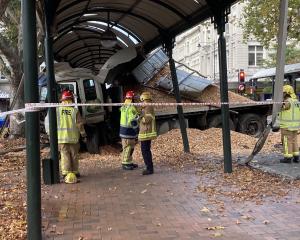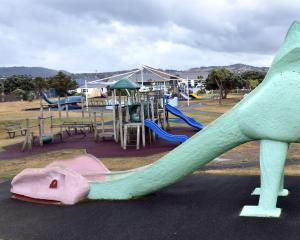With the city under siege from both the heavens and heaving seas, David Loughrey headed into the midwinter late afternoon gloom to walk broken coastal beachside pathways. As high tide battered the sand dunes, he found a claustrophobic city hemmed in by the elements, and learned something about Dunedin's personality.
Two sodden, formless ghouls rose dark and ominous from the Dunedin surf this week.
Battered by filthy waves that rolled through cold murk to the beach, the pair swayed and bulged as the water pulled their black skirts this way and that, next to the clattering rocks.
The two worked to escape the bitter embrace of the deep below a broken shoreline, where signs warned of anger at play, and paths once trod in summer's light now dropped darkly to jagged rubble below.
For the storm had come.
The sea had returned to reclaim its own.
It cut into sand dunes soft and yielding, it broke concrete, wood and asphalt, and worked to undo 150 years of the works of man - foolish man - who built his wall of sand.
The ghouls, of course, were just splintered poles wrapped in geotextile material ripped from the city's defences to create strange forms that told the story of the sea's cruel advances.
That story was of a city drenched by rains, which finds itself in a new and terrible state of siege by water.
Near high tide this week, the St Clair esplanade shuddered with every volley the sea fired.
Waves gathered just metres offshore, merged and rose high, then thundered at the seawall before slamming a foaming shoulder to its door.
Drawn by the pull of danger, residents gathered in small awed groups, staring mutely at the maelstrom with a stubborn, angry fear.
More gazed silently seaward at Middle Beach, where sand thrown from the coast's turmoil has buried the sideline of the nearby rugby field.
Birds sat still and silent on the grass.
As the tide reached its height, and the sky turned a russet blush, steel mesh cages filled with rocks to protect the dunes lay exposed on the beach; the dunes they were built to protect scoured and gone.
As at St Clair, the Middle Beach dunes that were left formed a threatening overhanging cliff, like a sword of Damocles over the city.
A dirty mist began to form above the simmering seas, the shifting sands and the muted cries of children at rugby practice on Kettle Park.
The mist soaked up the little light that was left from the day.
The clouds darkened to a battleship grey above, and in the distance, barely perceptible, a flock of birds formed a long line heading to safety inland.
It was just 4.30pm, but the city lights were on and shone brightly in the gloaming.
On John Wilson Ocean Dr drivers parked at wild angles, and sat in their cars gazing at the ocean.
St Kilda Beach was nothing more than a thin strip of sand, barely wide enough to walk on, the sea on one side and the battered dunes on the other hemming the traveller in as he picked his way over and past the detritus of the stormy sea.
The thick, cold air became more oppressive in the Andersons Bay Cemetery, and almost opaque at Tomahawk Beach.
On the beach the clouds lowered to just centimetres above the heads of the barely defined human forms and the three-legged dog that trod the darkening sands, then dropped lower, so travellers had to walk with a pronounced stoop.
They moved alongside yet more broken cliffs, where uprooted fence posts dangled on wires, a sign of nature's disdain for man's attempt to demarcate the earth.
And finally, on sodden sands on a foaming beach, night fell.
Trapped halfway up a sand hill with heavy seas cutting into its base, as the rain began to fall, the traveller had time to think about the ramifications of the last century and a-half of such forces of nature at Dunedin's gates.
Perhaps the ever-present fear of watery annihilation has made the city what it is.
Living in the shadow of death, we turn a stubborn face to God, sea and sky, daring them to do their worst.
We live conservative lives of hard work and virtue in buildings built of solid stone.
We shun the frivolous and flamboyant, lest we be damned by their proximity.
We are ever ready for final judgement should we be swallowed by the ocean.
We are Dunedin, the city by the sea.












